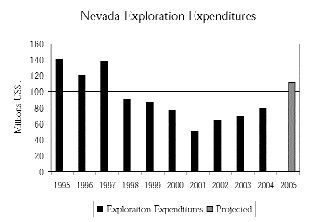Nevada’s minerals industry had an outstanding 2004, and the good times have continued into the first half of 2005.
Higher commodity prices for gold, silver and copper have stimulated expansion and exploration projects across the northern half of the state.
The average gold price in 2004 was US$410 versus US$363 in 2003 and US$310 in 2002 — substantially above the levels of the late 1990s when a gold price in the range of US$270 led to mine closures and layoffs.
While the industry looks healthy for the foreseeable future, 2004 witnessed the fourth consecutive year of declining gold production. Gold production fell to 6.94 million oz. from 7.32 million in 2003. Silver production, on the other hand, increased slightly to 10.3 million oz. in 2004 from 10.2 million in 2003. Gold, however, is by far the most economically significant mineral produced in the state with 2004 production worth US$2.8 billion. (Total mineral production was valued at US$3.3 billion, excluding oil).
At this level of production, Nevada remains the world’s third largest gold producer behind South Africa (11.1 million oz.) and Australia (7.8 million oz.). The world’s fourth largest producer, China, is closing in on Nevada with production of 6.8 million ounces. Nevada’s production in 2004 accounted for 8.7% of total world gold output.
For the past few years, declining gold production has largely been attributed to declining ore grades at some of the state’s older and larger operations. The decline should be offset somewhat in 2005 and 2006 as new projects and mine expansions go into production.
Perhaps the most serious problem facing the industry is rising production costs. Total cash production costs, which do not include non-cash items like depreciation, increased to US$250 per ounce from US$215 in 2003, a 16% hike. Similarly, total production costs, which include all costs attributable to production, increased to US$304 per ounce from US$277 in 2003, a rise of 9.6%. Rising energy costs for electricity and diesel fuel were behind much of the increase.
As a result of rising costs and declining output, proceeds from minerals taxes paid increased only slightly to US$39.6 million in 2004, from US$38.8 million a year earlier, an increase of 2% — despite a 13% increase in the price of gold.
In 2004 total taxes remained at about the same as 2003, increasing about 1% to US$102.4 million. The majority of these revenues accrued to local governments where mining activity occurs.
Another area of concern for Nevada is the length of time required to get permits to explore for minerals and develop projects. The industry has worked with state and federal regulators and the public to streamline the process while protecting Nevada’s environmental resources.
The most encouraging signs of recovery in the State’s minerals industry from the doldrums of the late 1990s are on the exploration side. According to Nevada’s Division of Minerals’ Exploration Survey 2004, exploration spending increased by 15% over 2003 to US$79.7 million and is projected to increase another 40.4% in 2005 to US$111.9 million (see table below). Exploration is largely focused in Humboldt, Lander and Eureka counties, but other counties are affected too.
In 2004, exploration activity at existing operations managed to increase statewide proven and probable gold reserves to 80.3 million oz. from 77.3 million oz. When production of 6.9 million oz. in 2004 is factored in, it means that these operations added about 9 million oz. to their reserves during the year. Reserves of 80.3 million oz. are sufficient to maintain production at current levels for 12 years, and these estimates have historically been low.
Another encouraging sign of recovery has been the 33.1% surge in employment and the 9.4% increase in payrolls over levels in 2003. While encouraging, this development has presented operators with serious challenges in maintaining staff and getting trained workers.
Other significant developments in 2004 and 2005 are as follows:
– Barrick Gold has extended the projected mine life of its Goldstrike operation to at least 2014.
– Glamis Gold and Barrick have begun their Millennium Expansion project at the Marigold Mine in Humboldt Cty. When finished, the changes will roughly triple production.
– Newmont Mining is in the permitting phase to build a 200 MW electrical generating plant in Eureka Cty. at an estimated cost of US$400 million to serve its operations on the Carlin and Valmy Trends.
— The preceding is an edited version of an Information Bulletin published by the Reno-based Nevada Mining Association.


Be the first to comment on "Higher gold price brings better times to Nevada"